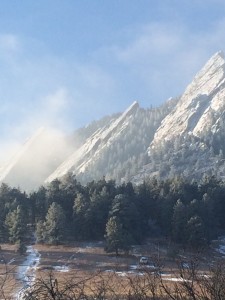Rambling: Christmas and the Winter Solstice
 This Morning’s Commute Scenery
This Morning’s Commute Scenery
Well we just passed the winter solstice a couple days ago. This is when we experience the longest night/shortest day of the year in the northern hemisphere. The daylight hours grow longer and the sun climbs higher in the ski for the next six months until the summer solstice. Since the hours of daylight and angle of the sun’s rays determine the average temperature, you might expect that the solstice would be the coldest day of the year, on average anyway.
Actually the coldest average temperature happens about a week after the solstice. The reason is because the earth and atmosphere act as a heat reservoir. This reservoir leaks heat continuously and is replenished by the sun. During the winter, the sun decreases its fill rate and eventually the heat leaking into space is greater than the replenish rate and the earth cools. So even though the sun is turning up its heating spigot after the solstice, it takes a few days before the replenish rate matches the heat loss rate. The same thing happens on a shorter time scale during the day. The hottest part of the day is not at noon but an hour or so later.
Ok, science lesson over.
Next: In two days it will be Christmas. This may or may not be the date Christ was born, but I find it very surprising that it happens only three or four days on the bright side of the solstice. Given that solstice celebrations are far more ancient and were widely practiced all over the northern hemisphere, it seems highly likely that Christmas day was set to coincide with these celebrations. There are of course arguments on both sides of this issue, but it remains that Christmas is now a de facto solstice celebration.
And now my conclusion: The reason we experience varying daylight hours, longer in the summer and shorter in the winter, is because the rotation axis of the earth is tilted 23 degrees from the plane that defines the earth’s orbit around the sun. If the axis were zero, day and night would be exactly the same length for the entire year. If the tilt were greater than 23 degrees, all kinds of freaky things would be different. Think about it for a few minutes.
That 23 degree axial tilt is the main driver of the seasons, and the Winter solstice is the inflection point of daylight hours and warming temperatures. It is something to celebrate.
SO… What is the true meaning of Christmas? 23 degrees.

Posted in Journal by Mark with comments disabled.